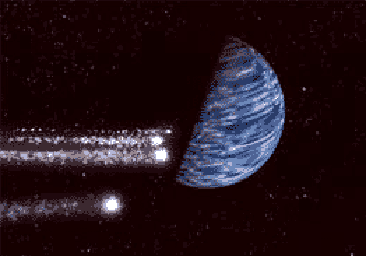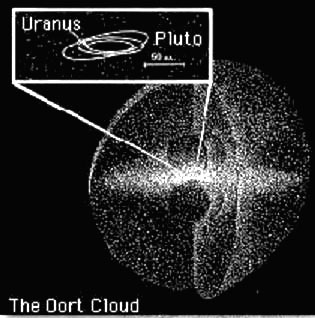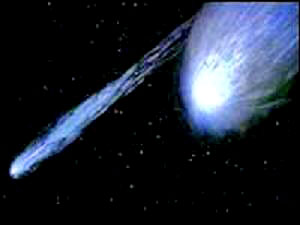|

from
WorldTopix Website
Nemesis is a hypothetical star orbiting the Sun at a distance of
about 50,000 to 100,000 AU, somewhat beyond a hypothetical cloud of
proto-comets at a great distance from the Sun ( the Oort cloud ).The
"Nemesis Theory" was an outgrowth of the discovery that the impact
of a large comet or asteroid was responsible for the great mass
extinction on Earth that took place 65 million years ago.
Nemesis' existence was proposed in 1984 by American physicists
Daniel Whitmire and Albert Jackson (The University of Southern
Louisiana) and also by Richard Muller, Piet Hut &
Davis M. in 1984 in
order to explain an apparent 26-million year cycle in the occurrence
of mass extinctions on Earth, like the one that killed the dinosaurs
65 million years ago, as noted by Raup and Sepkoski.
This hypothetical "death star" or "death companion" of the Sun has
received a name: Nemesis. In the Greek mythology Nemesis was the
spirit of divine retribution against those who succumb to hubris,
vengeful fate personified as a remorseless goddess.
According to the hypothesis, Nemesis periodically (approximately
every 26 million years) passes through a denser region of the Oort
cloud, disrupting the orbits of comets, and sending millions of
comets into the inner solar system and potential collision with the
Earth.
But, many geologists are convinced that mass extinctions on Earth are
not periodic, so they see no need for such a star. Nevertheless,
Richard Muller and his colleagues have embarked on the difficult
search for a possible, dim companion to the Sun - Nemesis.

According to the hypothesis Nemesis moves in an elliptical orbit,
its solar distance varying between 90,000 AU (1.4 light years) and
20,000 AU, with a period of 30 million years. It is dark or at least
very faint, so we haven't noticed it yet.
Once every 30 million years that companion star of the Sun (Nemesis)
would pass through a hypothetical cloud of proto-comets at a great
distance from the Sun (the Oort cloud). During such a passage, the
proto-comets in the Oort cloud would be stirred around. Some tens of
thousands of years later, here on Earth we would notice a dramatic
increase in the the number of comets passing the inner solar system.
If the number of comets increases significantly, so does the risk
of the Earth colliding with the nucleus of one of those comets.
When examining the Earth's geological record, it appears that about
once every 30 million years a mass extinction of life on Earth has
occurred. The most well-known of those mass extinctions is the
dinosaur extinction some 65 million years ago. According to this
hypothesis about 25 million years from now it's time for the next
mass extinction on Earth.
Richard Muller concluded that Nemesis is likely 1-1.5 light years
away at present, and even has ideas of what area of the sky it might
be in (supported by Yarris, 1987), near Hydra, based on a
theoretical orbit derived from original apogees of a number of
atypical long period comets that describe an orbital arc meeting the
specifications of Muller's theory. It was initially nicknamed the
"death star", after the fictional Star Wars weapon.
One of the criticisms of the Nemesis hypothesis was that passing
molecular clouds might already have depleted the Oort comet cloud to
such an extent that Nemesis would not have enough comets left to
modulate their impacts. This argument was shown to be wrong in the
article "Have Interstellar Clouds Disrupted the Oort Comet Cloud?"
by Hut & Tremaine.
A more serious criticism concerned the lack of stability of an orbit
around the Sun with a period of tens of millions of years. Such an
orbit would not be far from the sphere of influence of nearby stars,
which would constantly perturb the orbit. Not only would these
perturbations threaten to unbound Nemesis, they would also preclude
a precise periodicity, long before they would disrupt its orbit.
This problem was addressed through a large number of simulations of
different candidate Nemesis orbits in the article "How stable is an
astronomical clock which can trigger mass extinctions on earth?" by
Piet Hut where he showed that all is well: even though the orbital
periodicity will become noisy through the perturbations of other
stars, in most cases the periodicity is still well preserved over
the period of 250 million years for which Raup and Sepkoski
originally fitted the timing of the last ten major mass extinctions
on Earth.
One awkward fact of the Nemesis hypothesis is that there is no
evidence whatever of a companion star of the Sun. It need not be
very bright or very massive, a star much smaller and dimmer than the
Sun would suffice, even a brown or a black dwarf (a planet-like body
insufficiently massive to start "burning hydrogen" like a star). It
is possible that this star already exists in one of the catalogues
of dim stars without anyone having noted something peculiar, namely
the enormous apparent motion of that star against the background of
more distant stars (i.e. its parallax).
If it should be found, few
will doubt that it is the primary cause of periodic mass extinctions
on Earth.

If an anthropologist of a previous generation had heard such a story, the resulting scholarly tome would doubtless use words like
'primitive' or 'pre-scientific'.
There is another Sun in the sky, a Demon Sun we cannot see. Long
ago, the Demon Sun attacked our Sun. Comets fell, and a terrible
winter overtook the Earth. Almost all life on Earth was destroyed.
The Demon Sun has periodically attacked many times before. It will
attack again.
This is why some scientists thought this Nemesis theory was a joke
when they first heard of it: an invisible Sun attacking the Earth
with comets sounds like myth. It deserves an additional dollop of
skepticism for that reason: we are always in danger of deceiving
ourselves. But even if the theory is speculative, it's serious,
because its main idea is testable: you find the star and examine its
properties.
But, no direct proof of the existence of Nemesis has been found
yet. Also, the existence of a periodicity in the Earth's series of
mass extinctions is still disputed. Richard Muller has proposed
that, based on analysis of lunar rocks that indicate the impact
history of the Moon, a major uptick in lunar impacts 400 million
years ago represents a major shift in the orbit of Nemesis into its
present rather eccentric orbit, which according to Piet Hut will
only be stable for another billion years.
Matese and Whitman have suggested that the cycle might be caused by
the solar system oscillating across the galactic plane of the Milky
Way. These oscillations may lead to gravitational disturbances in
the Oort cloud with the same proposed consequences as the orbit of
"Nemesis". However, the period of oscillation is not
well-constrained observationally, and may differ from the needed 26
million years by as much as 40%.
Richard Muller has been engaged in searches for Nemesis and so far,
these searches have not turned up any solar companion star. A
complication in these searches is the fact that we have no idea
where in the sky Nemesis might reside: given the strong
perturbations of nearby stars, there is no reason to believe that
the star will be anywhere close to the ecliptic.
The Binary Research Institute (BRI) has found that orbital
characteristics of the recently discovered
planetoid, "Sedna",
demonstrated the possibility that the sun might be part of a binary
star system. A binary star system consists of two stars
gravitationally bound orbiting a common center of mass. Once thought
to be highly unusual, such systems are now considered to be common
in the Milky Way.
However, the question as to the existence of Nemesis will not remain
open indefinitely: as soon as a repeated infrared all-sky survey
will reach a positional sensitivity of an arc-second, even a dim
companion to the Sun can be discovered because of its lack of proper
motion.

Nemesis may be detected by the
planned
Pan-Starrs
or
LSST astronomical surveys, or similar future projects. If Nemesis is a
brown dwarf, as proposed by Whitmire and Jackson, then the upcoming
WISE mission, should find it.
WISE is a NASA-funded scientific research project that will provide
a vast amounts of information about the solar system, the Milky Way
and the Universe. Among the objects WISE will study are asteroids,
the coolest and dimmest stars, and the most luminous galaxies. WISE
is an unmanned satellite carrying an infrared-sensitive telescope
that will image the entire sky.
|



